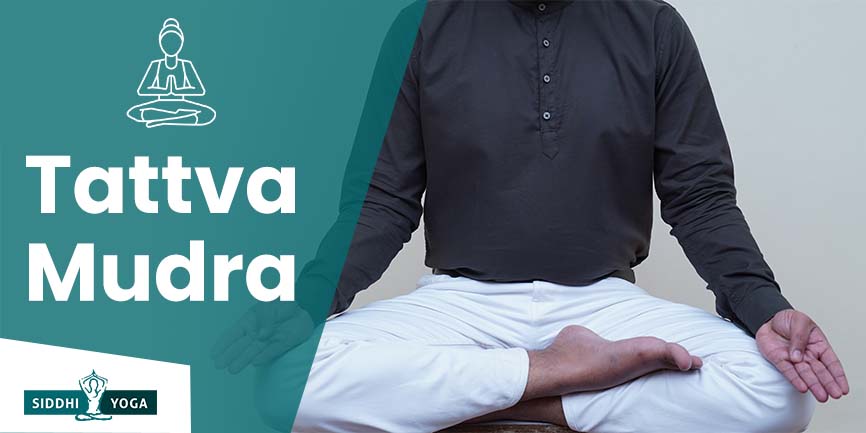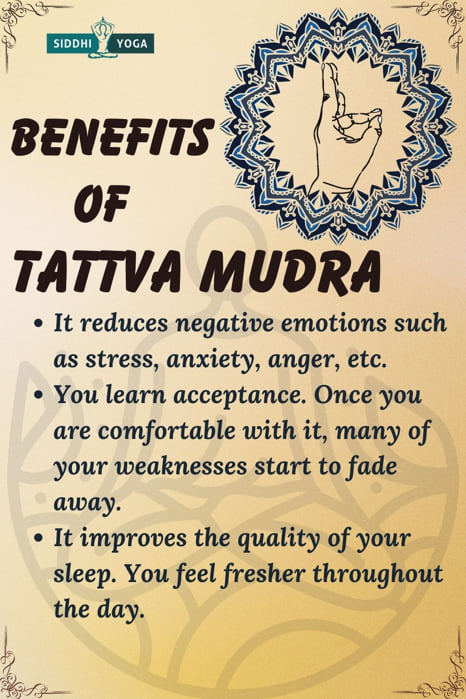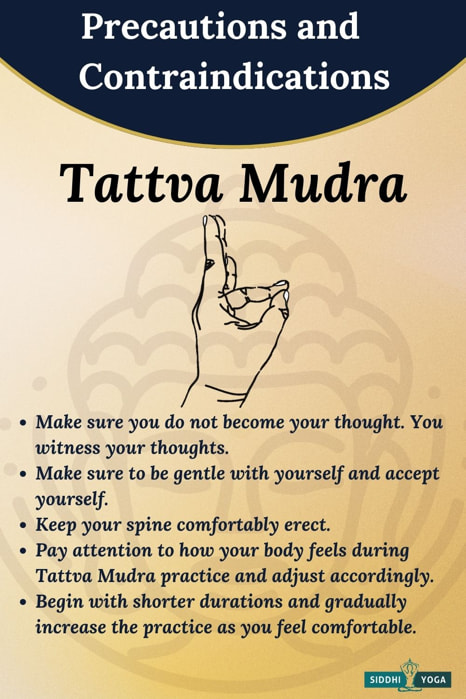
The Tattva Mudra is a hand gesture used in yoga with many benefits. This guide explains everything you need to know, including this Mudra’s meaning and benefits.
Definition – What is Tattva Mudra and its Meaning, References, and Mythology?
Tattva Mudra is one of the Samyukta Hasta Mudras or double-handed gestures or seals/locks. Let us break it down into two words to make it easier to understand.
Tattva – Some of you might be familiar with the Sanskrit word “Tattva.” It is the same word used to represent “Elements.” For instance, Fire Element is translated into Agni Tattva.
“Tattva” can also be translated into “Reality” or “Truth.”
Mudra – “Mudra” represents “Samyukta Hasta Mudra,” a double-handed gesture.
This Mudra is known as “The Truth Gesture” due to its amazing properties. In addition, this Mudra has a different Sanskrit name as well, “Aditi Mudra.”
Practicing this Mudra brings “yourself” closer to “your real self.” Somewhere in our heads, we tend to look at ourselves very differently. We do not understand the way we are, our basic nature, our likes, and our dislikes. We tend to ignore who we are and what we like. Therefore, we still feel empty inside, even after doing things we think we would like. We keep our real selves deep inside, which sometimes gets very difficult to access. Practicing this Mudra helps to rediscover this.
This Mudra includes Fire and Earth elements. However, the benefits that come from practicing this Mudra are more inclined towards the Earth element. It brings steadiness, strength, and stability to the body like Mother Earth. It also helps to balance the Kapha Doshas in the body.
Alternate Names of Tattva Mudra
The Truth Gesture, Aditi Mudra.
How to Do Tattva Mudra?
- This is one of the Mudras specific to practicing meditation or Dhyana. So, to gain maximum benefits of this Mudra, start by sitting in a comfortable meditative posture (Sukhasana, Padmasana, or Swastikasana). Whichever meditative posture is comfortable for you to practice for a long time.
- Keep your neck and spine comfortably erect.
- Rest both of your palms comfortably on your knee. Palms facing upward towards the sky.
- Gently close your eyes.
- Now, slowly place both of your thumbs at the root of your ring finger. While all the fingers should remain extended and joined to each other.
- Now, start to meditate. Start to pay more and more attention to your thoughts without engaging yourself in any thoughts. Just witness your thoughts flow.
- Witness your thoughts without losing the awareness of your breath. But once you improve your practice, you lose awareness of your thoughts.
- You can practice it with different Meditation techniques. The focus here is to understand yourself. Accept yourself without getting any negative thoughts.
Tattva Mudra Benefits

- To deepen your Meditative practice and better understand yourself, to understand the effects of this Mudra all by yourself, sit without having to utter anything. A complete silence. Try to sit still and watch the flow of your thoughts. You are a viewer who will watch your thoughts without indulging yourself in them. Let your thoughts do whatever they like, but you will not participate.
- It helps to concentrate and makes you feel more focused.
- Practicing this Mudra helps to balance the Kapha Doshas in the body.
- This Mudra helps to balance the earth element and the fire element. So, it gives benefits of both these elements.
- If you have too many thoughts in your mind that you cannot relax, then practicing this will result in a clearer thought process.
- It reduces negative emotions such as stress, anxiety, anger, etc.
- You learn acceptance. Once you are comfortable with it, many of your weaknesses start to fade away.
- It improves the quality of your sleep. You feel fresher throughout the day.
- As it calms the mind, it improves our body’s healing response.
Tattva Mudra Precautions and Contraindications

Similar to all other Mudra practices, it has no side effects.
However, there are a few things to consider:
- Make sure you do not become your thought. You witness your thoughts.
- Make sure to be gentle with yourself and accept yourself.
- Keep your spine comfortably erect.
When and how long to do Tattva Mudra?
- If you want to improve your meditation practices, try to practice this in conjunction with Pranayama. You will become more meditative and can maximize the outcomes of your practice.
- If you criticize yourself frequently, this Mudra is very important for you.
- You can practice this if you find yourself surrounded by stressors. It will help you to distance yourself from all the negativities.
- If you are experiencing any sleep-related issues, you should try it.
- If you have stress issues, memory loss, and digestive issues, then it serves a great value.
Morning is the ideal time to do any yoga or Mudra. In the morning, during the daytime, our brain is at its best. So, you are more likely to be able to concentrate easily. Therefore, you should practice this Mudra from 4 am and 6 am to get the most effective outcomes.
If you are having difficulty with this during the morning, you can do this Mudra later in the evening too.
Practicing this Mudra for a minimum of 30-40 minutes daily is recommended. Whether you wish to complete it in one stretch or two threes that last between 10 and 15 minutes, it’s up to you. Based on research, the best way to practice an exercise for at least 20 minutes is to get the best benefits of that particular Mudra.
Breathing in Tattva Mudra
- Abdominal Breathing and Yogic breathing.
- You can practice various Pranayama as well. It will exponentially increase its benefits.
Visualization in Tattva Mudra
Try to remember the last time when you criticize yourself. Try to remember if it was necessary. And try to let go of that feeling. Mentally repeat, “I am enough.”
Affirmation in Tattva Mudra
“I am enough.”
Conclusion
The Tattva Mudra is a Mudra, or hand gesture, used to balance the five elements within the body. These five elements are Earth, Water, Fire, Air, and Space. This Mudra helps bring about a sense of unity within the body and allows us to feel more connected to our surroundings. The benefits of this Mudra include improved concentration and memory, increased creativity and intuition, deep relaxation, and reduced stress and anxiety. If you’re interested in learning more about this and other Mudras and their benefits, check out our Mudras Certification Course. This course will teach you all 108 Mudras so that you can reap their maximum benefits.
Responses